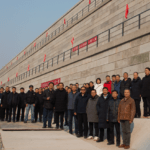 Professor Neil Dixon is a former IGS Council Member, former chair of the UK Chapter and current Professor of Geotechnical Engineering at the School of Architecture, Building and Civil Engineering at Loughborough University, UK.
Professor Neil Dixon is a former IGS Council Member, former chair of the UK Chapter and current Professor of Geotechnical Engineering at the School of Architecture, Building and Civil Engineering at Loughborough University, UK.
Prof Dixon will talk about sustainable geosynthetics solutions in a forthcoming lecture at the delayed EUROENGEO conference in April 2021.
Here, he explains the challenges and possible approaches to taking a greener route in tackling global engineering demands.
Sustainability. Why is it important for the geosynthetics industry?
We can make a real impact in the reduction of global C02 emissions thanks to a USP for geosynthetics applications: the ability to use marginal on-site materials such as soils and wastes produced in the construction process.
Normally, these materials are not used and transportation is needed to remove them from and to import replacement materials to sites. This movement of large volumes of materials is one of the major contributions to construction-generated CO2.
Re-using these materials on-site can therefore result in significant reductions in carbon emissions. If this is replicated on each infrastructure construction site worldwide then it would amount to a significant impact. The use of geosynthetics can contribute to meeting binding national CO2 emission targets and hence mitigate the impacts of climate change.
These solutions also nearly always cost the client less.
How else can geosynthetics contribute to a sustainable future?
They can be used to adapt our critical infrastructure to become more resilient to the impacts of climate change. In a wider definition, geosynthetics can help deliver sustainable life through control and storage of water, wastes etc. They can have a positive impact helping to deliver many of the UN Sustainable Development Goals.
What are the main challenges to more sustainable geosynthetics?
Geosynthetics are typically a petroleum product so at first appear to be very unsustainable. However, only small percentages of geosynthetic materials are normally used in construction projects. The savings in CO2 from use of the on-site materials far outweigh the embodied carbon in geosynthetic products.
More needs to be done to educate potential users.
Where are the main opportunities in terms of applications/use?
Geosynthetics can improve the engineering properties of marginal/poor fill materials (i.e. soils and waste) on-site, so as noted above, these do not have to be removed and hence new bulk fill materials do not have to be transported to the site.
What is the industry getting right?
Through IGS activities, the sustainability credentials and benefits of geosynthetic applications are now being disseminated to clients. Earlier this year the IGS published an eBook on sustainability; an informative resource explaining the many positives geosynthetics can offer.
DOWNLOAD A COPY (PDF)
Where can it improve?
The industry can do more to broadcast sustainability benefits and also work together to increase the size of the geosynthetics pie, with less emphasis on competing for a bigger piece of a smaller pie. I think we now know enough to be confident in the message the geosynthetics community can disseminate.
Are certain use cases doing better than others when it comes to sustainable geosynthetic use?
Yes, there is a strong sustainability case when geosynthetics can replace concrete in a design, and clients in a range of industries that employ geosynthetics are being informed of this benefit.
Can you give some examples of good use of incorporating geosynthetics in a sustainable way?
Yes. There are now multiple reports and academic papers that detail case studies. For example, a UK Waste and Resources Action Programme report published in 2010 reviewed six projects in the UK involving a range of reinforcement construction activities. It found solutions using geosynthetics led to significant cost and C02 (81% to 35%) savings because of the reduction in transporting fill materials to and from the sites.

You are set to deliver a keynote on sustainability at EUROENGEO next year. What do you hope to achieve?
I hope that engineering geology professionals will be better informed of the sustainability credentials of geosynthetics so that their use increases. Engineering geologists often play a pivotal role in the design of earthworks, and hence in deciding strategies for using materials on-site.
As for future keynotes, sadly my research on this topic has ended. I have given keynote lectures on sustainability at major IGS conferences in 2016 and 2018 so have helped to champion the cause. Others are now taking up the challenge.
Is there anything else you would like to add?
In 2015 I co-created a film titled ‘Geosynthetics for Sustainable Development’ with the IGS’s Sam Allen and Dr Gary Fowmes. This has been translated into multiple languages. It is aimed at informing potential clients about the benefits of using geosynthetics. You can watch it here.
* EUROENGEO takes place April 8-12, 2021. Click here for conference updates.






















